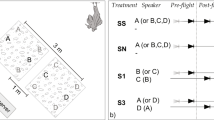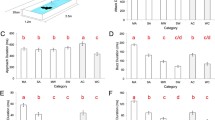Abstract
The foraging and echolocation behaviour of Myotis evotis was investigated during substrate-gleaning and aerial-hawking attacks. Bats gleaned moths from both the ground and a bark-covered trellis, however, they were equally adept at capturing flying moths. The calls emitted by M. evotis during substrate-gleaning sequences were short, broadband, and frequency-modulated (FM). Three behavioural phases were identified: search, hover, and attack. Gleaning search calls were significantly longer in duration, lower in highest frequency, and larger in bandwidth than hover/attack calls. Calls were detected in only 68% of gleaning sequences, and when they were emitted, bats ceased calling ∼ 200 ms before attacking. Terminal feeding buzzes, the rapid increase in pulse repetition rate associated with an attempted prey capture, were never recorded during gleaning attacks. The echolocation calls uttered by M. evotis during aerial-hawking foraging sequences were also short duration, high frequency, FM calls. Two distinct acoustic phases were identified: approach and terminal. Approach calls were significantly different from terminal calls in all variables measured. Calls were detected in 100% of aerial-hawking attacks and terminal feeding buzzes were invariably produced. Gleaning hover/attack calls were spectrally similar to aerial approach calls, but were shorter in duration and emitted at a significantly lower (but constant) repetition rate than aerial signals. Although the foraging environment (flight cage contents) remained unchanged between tasks (substrate-gleaning vs. aerial-hawking), bats emitted significantly lower amplitude calls while gleaning. We conclude that M. evotis adjusts its echolocation behaviour to meet the perceptual demands (acoustical constraints) imposed by each foraging situations.
Similar content being viewed by others
Abbreviations
- BW:
-
bandwidth
- CF:
-
constant frequency
- dB SPL:
-
decibels sound pressure level
- FM:
-
frequency modulated
- HF:
-
highest frequency
- LF:
-
lowest frequency
- PF:
-
peak frequency
References
Barclay RMR (1986) The echolocation calls of hoary (Lasiurus cinereus) and silver-haired (Lasionycteris noctivagans) bats as adaptations for long-versus short-range foraging strategies and the consequences for prey selection. Can J Zool 64:2700–2705
Barclay RMR (1991) Population structure of temperate zone insectivorous bats in relation to foraging behaviour and energy demand. J Anim Ecol 60:165–178
Barclay RMR, Fenton MB, Thomas DW (1979) Social behavior of the little brown bat, Myotis lucifugus. II. Vocal communication. Behav Ecol Sociobiol 6:137–146
Barclay RMR, Fenton MB, Tuttle MD, Ryan MJ (1981) Echolocation calls produced by Trachops cirrhosus (Chiroptera: Phyllostomatidae) while hunting for frogs. Can J Zool 59:750–753
Bell GP (1982) Behavioral and ecological aspects of gleaning by a desert insectivorous bat, Antrozous pallidus (Chiroptera: Vespertilionidae). Behav Ecol Sociobiol 10:217–223
Bell GP (1985) The sensory basis of prey location by the California leaf-nosed bat Macrotus californiens (Chiroptera: Phyllostomidae). Behav Ecol Sociobiol 16:343–347
Bell GP, Fenton MB (1984) The use of Doppler-shifted echoes as a flutter detection and clutter rejection system: the echolocation and feeding behavior of Hipposideros ruber (Chiroptera: Hipposideridae). Behav Ecol Sociobiol 15:109–114
Bell GP, Fenton MB (1986) Visual acuity, sensitivity and binocularity in a gleaning insectivorous bat, Macrotus californiens (Chiroptera: Phyllostomidae). Anim Behav 34:409–414
Beuter KJ (1980) A new concept of echo evaluation in the auditory system of bats. In: Busnel R-G, Fish JF (eds) Animal sonar systems. NATO ASI Series, Series A: Life Sciences Vol 28. Plenum Press, New York London, pp 747–761
Davis R (1968) Wing defects in a population of pallid bats. Am Midl Nat 79:388–395
Faure PA (1990) The foraging behaviour and sensory basis of prey detection by the long-eared bat, Myotis evotis. MSc Thesis, The University of Calgary, Alberta
Faure PA, Barclay RMR (1992) The sensory basis of prey detection by the long-eared bat, Myotis evotis, and the consequences for prey selection. Anim Behav 44:31–39
Faure PA, Fullard JH, Barclay RMR (1990) The response of tympanate moths to the echolocation calls of a substrate gleaning bat, Myotis evotis. J Comp Physiol A 166:843–849
Faure PA, Fullard JH, Dawson JW (1993) The gleaning attacks of the northern long-eared bat, Myotis septentrionalis, are relatively inaudible to moths. J Exp Biol 178:173–189
Fenton MB (1990) The foraging behaviour and ecology of animaleating bats. Can J Zool 68:411–422
Fenton MB, Bell GP (1979) Echolocation and feeding behaviour in four species of Myotis (Chiroptera). Can J Zool 57:1271–1277
Fenton MB, Gaudet CL, Leonard ML (1983) Feeding behaviour of the bats Nycteris grandis and Nycteris thebaica (Nycteridae) in captivity. J Zool (Lond) 200:347–354
Fiedler J (1979) Prey catching with and without echolocation in the Indian false vampire (Megaderma lyra). Behav Ecol Sociobiol 6:155–160
Griffin DR (1971) The importance of atmospheric attenuation for the echolocation of bats (Chiroptera). Anim Behav 19:55–61
Griffin DR, Webster FA, Michael CR (1960) The echolocation of flying insects by bats. Anim Behav 8:141–154
Hartley DJ, Campbell KA, Suthers RA (1989) The acoustic behavior of the fish-catching bat, Noctilio leporinus, during prey capture. J Acoust Soc Am 86:8–27
Jones G, Rayner JMV (1988) Flight performance, foraging tactics and echolocation in free-living Daubenton's bats Myotis daubentoni (Chiroptera: Vespertilionidae). J Zool (Lond) 215:113–132
Jones G, Rayner JMV (1989) Foraging behavior and echolocation of wild horseshoe bats Rhinolophus ferrumequinum and R. hipposideros (Chiroptera, Rhinolophidae). Behav Ecol Sociobiol 25:183–191
Kalko EKV, Schnitzler H-U (1989) The echolocation and hunting behavior of Daubenton's bat, Myotis daubentoni. Behav Ecol Sociobiol 24:225–238
Kick SA, Simmons JA (1984) Automatic gain control in the bat's sonar receiver and the neuroethology of echolocation. J Neurosci 4:2725–2737
Kober R, Schnitzler H-U (1990) Information in sonar echoes of fluttering insects available for echolocating bats. J Acoust Soc Am 87:882–896
Krull D, Schumm A, Metzner W, Neuweiler G (1991) Foraging areas and foraging behavior in the notch-eared bat, Myotis emarginatus (Vespertilionidae). Behav Ecol Sociobiol 28:247–253
Lawrence BD, Simmons JA (1982) Measurements of atmospheric attenuation at ultrasonic frequencies and the significance for echolocation by bats. J Acoust Soc Am 71:585–590
Marimuthu G, Neuweiler G (1987) The use of acoustical cues for prey detection by the Indian false vampire bat, Megaderma lyra. J Comp Physiol A 160:509–515
Miller LA, Degn HJ (1981) The acoustic behavior of four species of vespertilionid bats studied in the field. J Comp Physiol 142:67–74
Neuweiler G (1983) Echolocation and adaptivity to ecological constraints. In: Huber F, Markl H (eds) Neuroethology and behavioral physiology. Springer, Berlin Heidelberg New York Toyko, pp 280–302
Neuweiler G (1984) Foraging, echolocation and audition in bats. Naturwissenschaften 71:446–455
Neuweiler G (1989) Foraging ecology and audition in echolocating bats. Trends Ecol Evol 4:160–166
Neuweiler G (1990) Auditory adaptations for prey capture in echolocating bats. Physiol Rev 70:615–641
Norberg UM, Rayner JMV (1987) Ecological morphology and flight in bats (Mammalia; Chiroptera): wing adaptations, flight performance, foraging strategy, and echolocation. Phil Trans R Soc Lond B 316:335–427
Pye JD (1980) Echolocation signals and echoes in air. In: Busnel R-G, Fish JF (eds) Animal sonar systems. NATO ASI Series, Series A: Life Sciences Vol 28. Plenum Press, New York London, pp 309–353
Ryan MJ, Tuttle MD (1987) The role of prey-generated sounds, vision, and echolocation in prey localization by the African bat Cardioderma cor (Megadermatidae). J Comp Physiol A 161:59–66
Rydell J (1990) Behavioural variation in echolocation pulses of the northern bat, Eptesicus nilssoni. Ethology 85:103–113
Schmidt S (1988) Evidence for a spectral basis of texture perception in bat sonar. Nature 331:617–619
Schmidt S (1992) Perception of structured phantom targets in the echolocating bat Megaderma lyra. J Acoust Soc Am 91:2203–2223
Schnitzler H-U (1987) Echoes of fluttering insects: information for echolocating bats. In: Fenton MB, Racey P, Rayner JMV (eds) Recent advances in the study of bats. Cambridge Univ Press, Cambridge, pp 226–243
Schnitzler H-U, Kalko E, Miller L, Surlykke A (1987) The echolocation and hunting behavior of the bat, Pipistrellus kuhli. J Comp Physiol A 161:267–274
Schumm A, Krull D, Neuweiler G (1991) Echolocation in the notcheared bat, Myotis emarginatus. Behav Ecol Sociobiol 28:255–261
Shapiro SS, Wilk MB (1965) An analysis of variance test for normality (complete samples). Biometrika 52:591–611
Simmons JA (1987) Acoustic images of target range in the sonar of bats. Naval Res Rev 39:11–26
Simmons JA, Stein RA (1980) Acoustic imaging in bat sonar: echolocation signals and the evolution of echolocation. J Comp Physiol 135:61–84
Simmons JA, Lavender WA, Lavender BA, Childs JE, Hulebak K, Rigden MR, Sherman J, Woolman B, O'Farrell MJ (1978) Echolocation by free-tailed bats (Tadarida). J Comp Physiol 125:291–299
Simmons JA, Fenton MB, O'Farrell MJ (1979a) Echolocation and pursuit of prey by bats. Science 203:16–21
Simmons JA, Fenton MB, Ferguson WR, Jutting M, Palin J (1979b) Apparatus for research on animal ultrasonic signals. Roy Ont Mus Life Sci Misc Publ
Simmons JA, Kick SA, Moffat AJM, Masters WM, Kon D (1988) Clutter interference along the target range axis in the echolocating bat, Eptesicus fuscus. J Acoust Soc Am 84:551–559
Simmons JA, Moss CF, Ferragamo M (1990a) Convergence of temporal and spectral information into acoustic images of complex sonar targets perceived by the echolocating bat, Eptesicus fuscus. J Comp Physiol A 166:449–470
Simmons JA, Ferragamo M, Moss CF, Stevenson SB, Altes RA (1990b) Discrimination of jittered sonar echoes by the echolocating bat, Eptesicus fuscus: the shape of target images in echolocation. J Comp Physiol A 167:589–616
Sum YM, Menne D (1988) Discrimination of fluttering targets by the FM-bat Pipistrellus stenopterus? J Comp Physiol A 163:349–354
Surlykke A (1992) Target ranging and the role of time-frequency structure of synthetic echoes in big brown bats, Eptesicus fuscus. J Comp Physiol A 170:83–92
Vaughan TA (1976) Nocturnal behavior of the African false vampire bat (Cardioderma cor). J Mammal 57:227–248
Vogler B, Neuweiler G (1983) Echolocation in the noctule (Nyctalus noctula) and horseshoe bat (Rhinolophus ferrumequinum). J Comp Physiol 152:421–423
Zar JH (1984) Biostatistical analysis. Prentice-Hall Inc, New Jersey
Zbinden K (1988) Harmonie structure of bat echolocation signais. In: Nachtigall PE, Moore PWB (eds) Animal sonar: processes and performance. NATO ASI Series, Series A: Life Sciences Vol 156. Plenum Press, New York London, pp 581–587
Author information
Authors and Affiliations
Rights and permissions
About this article
Cite this article
Faure, P.A., Barclay, R.M.R. Substrate-gleaning versus aerial-hawking: plasticity in the foraging and echolocation behaviour of the long-eared bat, Myotis evotis . J Comp Physiol A 174, 651–660 (1994). https://doi.org/10.1007/BF00217386
Accepted:
Issue Date:
DOI: https://doi.org/10.1007/BF00217386




